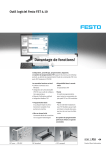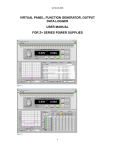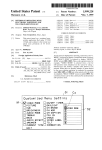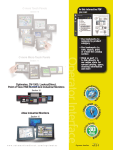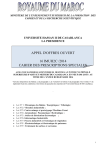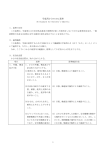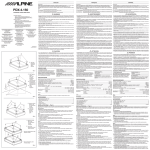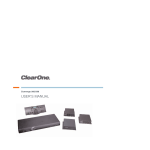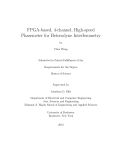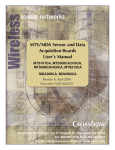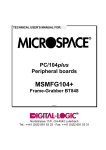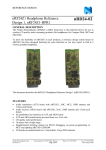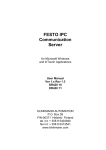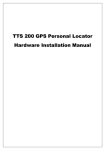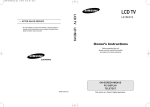Download GSM-5000 Cellular Mobile Trainer
Transcript
www.igoodtech.com 2011~2012 Good-Tech ‘ Educational T raining S ystem’ Globel Business Company. Leading Laboratory Equipment Supplier. Teacher & Professor's optimal solution for their classroom. Broad portfolio of Information Technology Training Products. Meaningful training products closely related with commercial products. Contents GSM-5000 model: Cellular Mobile Trainer (GSM/GPRS Trainer) WCDMA-5000 model: Cellular Mobile Trainer (WCDMA Trainer) CMTS-G7000M GSM / GPRS type, Cellular Mobile Netwotk Analyzing System (Multi DM + PC based) model: CMTS-GW7000M model: GSM / WCDMA type, Cellular Mobile Network Analyzing System (Multi DM + PC based) 04 07 11 GPS-5000 GPS Trainer 15 MGT-1000 Mobile Game Trainer 17 MGT-3000 Mobile Game Trainer 19 model: model: model: Android -5000 model: PIC-16F874 model: 21 Smart Phone Trainer 26 PIC Trainer (PIC16F874) Microprocessor-8051 Microprocessor Trainer 28 Microprocessor-AVR Microprocessor Trainer 30 model: model: Microprocessor-Cortex-M3 model: model: 01 Microprocessor Trainer Microprocessor-8051,AVR,Cortex-M3 FPGA/SoC-5000 model: Digital-5000 model: DSP-5000 model: Microprocessor Trainer FPGA / SoC Trainer Digital Communication Trainer DSP Trainer 32 34 37 41 43 Cellular Mobile Trainer (GSM/GPRS Trainer) GSM-5000 model: Cellular Mobile Trainer (GSM/GPRS Trainer) Feature GSM-5000 is the training system enabling users to study GSM/GPRS communication protocol and to experience the overall knowledges about mobile communication through GSM module control. To control the GSM module, there is advanced set of AT Commands according to GSM ETSI (European Telecommunications Standard Institutes). GSM-5000 has full training contents of Command Level Study on AT Commands. GSM-5000 is based upon GSM cellular phone and allows for connection to PC for operation and programming. This trainer is designed to instruct the students System operation, Theory, Programming, Servicing, Problem diagnosis of GSM cellular mobile systems. GSM-5000 is mainly used for students to learn fundmentals in mobile communication systems such as mobile station network entry, calling process, network signals, AT Commands, Audio communication, Short message services,,,etc. The training covers the command level study with AT Commands, GPRS Intenet Connection, Multiplexer Protocol training and Hardware test experiments, Introduce of Embedded OS system and GUI programming on GSM-5000 through the provided source codes. Functions - Understanding of GSM technology & network, GSM capability & data services. - Real Time Study of GSM 07.05 & 07.07 and ITU-T recommendation V.25ter with AT command - Study of SIM card interface and SIM data control - Study of GSM 07.10 Multiplexer Protocol - GSM network by actually connecting to the GSM environment - Development Windows CE based user application - Debugging experience with serial port Components GSM Hardware platform with GSM module and Embedded system board (GSM Modem and Antenna was installed to Hardware board) AC Adapter RS232C Cable for debugging Ear Set (Ear Phone + Mic) GSM Mobile phone (user's mobile phone can be used) Software installation CD User's Manual USIM Card - 01 - 1 ea 1 ea 1 ea 1 ea 0 1 ea 1 ea 1 ea Cellular Mobile Trainer (GSM/GPRS Trainer) System cinfiguration 1) GSM Hardware platform with GSM module and Embedded system board 2) System operating configuration Training contents Chapter 1. Understanding of GSM Chapter 5. Call Setting and Command 1.1 History 1.2 Technical Specification 1.3 Definition of Terms Chapter 2. Command for modem & sim card hardware 2.1 What are AT Commands? 2.2 AT Command Standards 2.3 AT Command Syntax 2.4 AT commands in SIM900 2.5 SIM Card 2.6 AT Commands Related to Modem and SIM Card 2.7 Using the GSM Trainer 2.8 Practice 2.9 Practice Report Chapter 3. Network Registration and Command 5.1 AT Commands Related to Call Setting 5.2 Practice 5.3 Practice Report Chapter 6. Call Information and Command 6.1 Mobile Subscriber Identify in the GSM Network 6.2 AT commands related to Call Information 6.3 Practice 6.4 Practice Report Chapter 7. Short Message Service (SMS) and Command 7.1 What’s SMS service? 7.2 AT Commands Related to SMS 7.3 Practice 7.4 Practice Report Chapter 8. Message Setting and Command 3.1 AT Commands Related to Network Registration 3.2 Practice 3.3 Practice Report Chapter 4. Call Processing Control and Command 8.1 AT Commands Related to Message Setting 8.2 Practice 8.3 Practice Report Chapter 9. Cell ID Check for handover 4.1 AT Commands Related to Call Processing 4.2 Practice 4.3 Practice Report 9.1 Handover 9.2 AT Commands Related to Cell ID check for handover 9.3 Practice - 02 - Cellular Mobile Trainer (GSM/GPRS Trainer) 14.2 ActiveSync 9.4 Practice Report Chapter 10. Make PPP Connection Chapter 15. Build & Debugging CE Application 10.1 Basic Understanding of PPP 10.2 Configure PPP in the GSM Trainer 10.3 Change PPP in the GSM Trainer 10.4 Disconnect PPP in the GSM Trainer 15.1 Environment Setup for Application 15.2 SDK(Software Development Kit) Installation 15.3 Create Application Chapter 16. SIM900B module Chapter 11. Internet Connection with Browser 16.1 SIM900B Description 16.2 Application Interface 11.1 Internet Connection Chapter 12. MUX Driver Load / Unload Chapter 17. Phonebook 12.1 MUX driver load / unload 12.2 AT commands related to MUX driver load / unload 12.3 Practice 12.4 Practice Report Chapter 13. Test Multiple Serial Port 17.1 AT Commands related to Phonebook 17.2 Practice 17.3 Practice Report Appendix 13.1 Open COM6 through the practice program GsmTest 13.2 Open COM5 via PPP Connection for Internet 1. Introduction Global System for Mobile Communications 2. Introduction to WCDMA 3. LTE introduction Chapter 14. Windows CE Configuration 14.1 Windows CE 6.0 Specification 1. Hardware Spec 1) OS : Microsoft Windows CE.NET 6.0 2) CPU : ARM11 500MHz Processor (ATLAS-IV) 3) Memory : 128MB SDRAM, 2G NAND Flash 4) Display interface : 7 inch TFT LCD / 800*480 Pixels / Touch screen 5) Audio : Stereo Audio CODEC, Built-in Speaker, MIC for GSM 6) Output : Data indication LED, Debug serial port / USB 2.0 Port 7) Power : 5V, 1.5A AC 8) SIM : Built-in SIM card slot / 1.8V, 3V SIM card support 9) GSM/GPRS features (1) GSM Module : SIM900B (2) Quad-band GSM/GPRS ·GSM 850MHz ·EGSM 900MHz ·DCS 1800MHz ·PCS 1900MHz (3) GSM Class : Small MS (4) Transmitting power: ·Class 4 (2W) at GSM 850 and EGSM 900 ·Class 1 (1W) at DCS 18000 and PCS 1900 (5) GPRS connectivity ·GPRS multi-slot class 10 (Default) ·GPRS multi-sloc class 8 (Optional) ·GPRS mobile station class B (6) DATA GPRS ·GPRS data downlink transfer: max. 85.6kbps ·GPRS data uplink transfer: max. 42.8kbps ·GPRS coding schemes: CS-1, CS-2, CS-3, CS-4 ·Supports the protocols PAP (Password Authentication Protocol) usually used for PPP connections ·Integrates the TCP/IP protocol ·Support Packet Switched Broadcast Control Channel (PBCCH) (7) SMS ·MT, MO, CB, Text and PDU mode ·SMS storage: SIM card (8) Serial Port ·1200bps to 115200bps ·Serial Port can be used for AT command or data stream ·Supports RTS/CTS hardware handshake and software ON/OFF flow control ·Multiplex ability according to GSM 07.10 Multiplexer Protocol. ·Autobauding supports baud rate from 1200 bps to 57600 bps 2. Software Spec C/C++ language User Interface on LCD GSM Driver - 03 - Cellular Mobile Trainer (WCDMA Trainer) (model : WCDMA-5000) WCDMA-5000 model: Cellular Mobile Trainer (WCDMA Trainer) Feature W-CDMA (Wideband Code Division Multiple Access) is an air interface standard found in 3G mobile telecommunications networks. 3G is a generation of standards for mobile phones and mobile telecommunications services. Application services include wide-area wireless voice telephone, mobile Internet access, video calls and mobile TV, all in a mobile environment. WCDMA-5000 gives the understanding for the air interface standard of 3GPP, and the training for the logic design of signal modulation and de-modulation as well as encoding. Also, WCDMA-5000 gives an actual practice for Voice Call Processing, Video Telephony Processing, Hand-off Practice, Power Control Practice,,, etc. Also, it teaches the design method of physical layer software which enables the result of logic design to operate normally. Functions 1) WCDMA-5000 is the Training system having 3G Mobile Communication Standards. 2) WCDMA-5000 is the upgraded Mobile Communication system having Data, Voice and Video Call processing than the existing CDMA, GSM system. 3) As WCDMA-5000 equipped with MSM6245 WCDMA/EDGE/GPRS/GSM (WEDGE) Chipset which manufactured by Qualcomm for 3G Mobile Phone, Video Call and Voice Call is possible. 4) Mobile development training is available through Qualcomm BREW platform. 5) Through QVGA 2.4”(320x240) TFT color LCD, Video and Camera VOD can be received. 6) Through the USB/Serial interface, various communication module and Multi-media module can be mounted. 7) By providing Bluetooth headset, Speaker, Micro-phone, Earphone, user can easily do various & practictical practices. 8) Without a separate Base Station device, user can use their Mobile phone by changing USIM Chip from USIM Card. 9) Supports WCDMA (UMTS), EDGE and GSM/GPRS networks. 10) ARM926EJ-S™ microprocessor core with memory management unit (MMU) 11) QDSP4000™ high-performance digital signal processors. 12) ARM Jazelle™ Java hardware acceleration 13) Support for BREW and Java applications 14) Q camera™: Up to 2 megapixel digital images 15) Mobile video solutions: video streaming, playback, recording, and video telephony module can be mounted. 16) Digital audio support for MP3/AAC/aacPlus™/Enhanced aac Plus 17) CMX : Customized ringtone, screensaver and greeting card solution 18) Integrated Universal Serial Bus (USB) support 19) Bluetooth 1.1 connectivity 20) 2D/3D graphics System Configuration - 04 - Cellular Mobile Trainer (WCDMA Trainer) (model : WCDMA-5000) Training Contents Chapter 1, WCDMA development environment 1.1 Introduction to Wireless Mobile Communication 1.2 Introduction to WCDMA development environment 1.2.1 - Build environment 1.3 Practice 1.3.1 - Making Build environment 1.3.2 - Make build 1.3.3 - Download 1.3.4 - Debugging practice Chapter 2, Firmware Programming 2.1 WCDMA -3G Platform introduction 2.1.1 - WCDMA ? 3G Platform Hardware 2.1.2 - WCDMA ? 3G Platform Software 2.2 Board Support Package 2.2.1 - Boot method 2.2.2 - Memory Interface 2.2.3 - Booting process 2.3 LCD Drive implementation 2.3.1 - General 2.3.2 - Interface spec 2.3.3 - Principles of Operation 2.3.4 - Driver design 2.4 LCD Driver design practice 2.4.1 - Booting image exchange practice 2.4.2 - Image update practice 2.4.3 - Font display practice Chapter 3, WCDMA Physical Layer 3.1 WCDMA Technology introduction 3.2 WCDMA Channel structure 3.2.1 - Downlink channel structure 3.2.2 - Uplink channel structure 3.3 Practice 3.3.1 - WCDMA Active Set PSC strength practice 3.3.2 - Pilot Channel Scanner practice 3.3.3 - Layer 1 status monitoring practice 3.3.4 - Channel operation checking practice Chapter 4, UMTS Network 4.1 UMTS Introduction 4.1.1 - Non-Access Stratum 4.1.2 - Access Stratum 4.2 Core Network 4.2.1 - Core Service Domain 4.2.2 - Packet service Domain 4.2.3 - Registers Domain 4.3 UMTS Terrestrail Radio Access Network 4.4 UE (User Equipment) 4.4.1 - ME (Mobile equipment) 4.4.2 - UMTS Subscriber Identity Module Chapter 5, MAC (Medium Access Control) Layer 5.1 MAC introduction 5.2 MAC-b entity 5.3 UE MAC Structure 5.3.1 MAC - c/sh entities 5.3.2 MAC - d entities 5.3.3 MAC - hs entities 5.4 UTRAN Network MAC Structure 5.4.1 - MAC - c/sh entities for UTRAN Network 5.4.2 - MAC - d entities for UTRAN Network 5.4.3 - MAC- hs entities for UTRAN Network 5.5 MAC PDU (Protocol Data Units) 5.5.1 - MAC Header to Dedicated channel 5.6 Data Flow & Memory control between layers 5.7 Real Practice 5.7.1 - Practice contents 5.7.2 - BCH Header processing design 5.7.3 - BCH Header processing implementation 5.7.4 - Transport Block processing 5.7.5 - Transport Block processing design Chapter 6, RLC (Radio Link Control) Layer 6.1 RLC Introduction 6.2 RLC Entities 6.3 RLC Functionality 6.4 The Service which provided to higher Layer 6.5 RLC Layer design 6.6 Real RLC Practice Chapter 7, RRC (Radio Resource Control) Layer 7.1 RRC Layer introduction 7.2 RRC Layer structure 7.3 RRC State 7.4 RRC Function 7.5 RRC Task 7.6 Real RRC Practice Chapter 8, Call Processing Service for Voice 8.1 Call Processing Introduction 8.2 Call Processing for UE Voice sending 8.3 Call processing for UE Voice receiving 8.4 Call Release Procedures 8.4.1 Call Release procedures by UE 8.4.2 Call Release procedures by Network 8.5 Physical process for Voice information 8.6 Real Practice Chapter 9, Call Processing Service for Video Telephony 9.1 Video Telephony Processing 9.2 UE Video Telephony Processing 9.3 Physical Transmitting Procedures for Video Information 9.4 Real Practice Chapter 10, Hand Over 10.1 Hand Over Technology 10.2 CDMA Hand Over 10.2.1 - Idle Hand Over 10.2.2 - Hand Over in Traffic State 10.3 WCDMA Hand Over 10.4 Real Practice Chapter 11, Power Control 11.1 Introduction of Power Control 11.2 CDMA Power Control Technology 11.2.1 - Reverse Power Control 11.2.2 - Forward Power Control 11.3 WCDMA Power Control 11.3.1 - Open Loop Power Control 11.3.2 - Inner Loop Power Control 11.4 Real Practice Chapter 12, Download Implementation of 3G-WCDMA 12.1 Algorithm Overview of Downloading 12.1.1 - J-TAG Downloading method 12.1.2 - Downloading Program method 12.2 Asynchronous HDLC Protocol 12.3 AMSS Diagnosis Packet Service 12.4 Downloading Protocol 12.5 Real Practice Chapter 13, Brew Programming 13.1 BREW (Binary, Runtime, Environment, Wireless) 13.2 BREW Structure 13.3 BREW Installation 13.4 BREW SDK 13.5 Real Practice - 05 - Cellular Mobile Trainer (WCDMA Trainer) (model : WCDMA-5000) Components Items Main Hardware platform Manual book USIM CARD (User’s mobile phone USIM Card can be used to this system, so no need to provide new one) S/W CD Serial cable USB Cable Power Adaptor Num 1 ea 1 ea Not provided 1 ea 1 ea 1 ea 1 ea Hardware Spec Item Processor Memory Modem RF PMU Frequency band Wireless Protocol LCD Camera processor Video telephony Audio Vo-coder Audio/video decoders Bluetooth USB UART1 UART2 Keypad LED Indicator RF connector Antenna USB connector JTAG connector Input Power Extension slot Spec Qualcomm MSM6245 Chipset (ARM926EJ-S 225MHZ) QDSP -100MHz SDRAM 512MB, NAND 512Mb WCDMA, GSM, GPRS, EDGE, DTM RTR6275, PAM, TCXO(19.2MHz) PMIC6650-2 2100MHz (WCDMA Frequency) 3GPP WCDMA R99, Release 5 compliance, Jun 2005 for WCDMA 260K colors QVGA 2.4”TFT LCD Qualcomm Q camera TM Qvideo phone, 15fps QCIF 1 loud Speaker, 1 Microphone, 1 stereo Ear Phone Jack AMR MP3, AAC, AAC+, ADPCM, MPEG-4, H263, H264 Qualcomm Blue QTM? USB 1.1 slave and host (OTG) RS-232 9-pin connector USIM interface 22 keys 5 LEDs( Reset, PS hold, PA on, NAND CE, Camera power on) SMA external type connector Chip Antenna General USB Interface JTAG Compatible(ANSI/IEEE1149.1A-1993) 20pin 9V DC Power Supply GPIO[1-5], I2C, UART Software Spec Item Wireless Protocol Platform BT GUI USB Spec 1) 3GPP Release 99 and 5 compliance 2) SMS : 3GPP TS 23.040 Technical realization of the Short Message Service (SMS) 3) 3GPP TS 24.011 Point-to-Point (PP) Short Message Service (SMS) Support on Mobile Radio Interface. 4) USIM : 3GPP TS 23.048 Security Mechanisms for the (U)SIM application toolkit 5) Video Service : 3GPP Release 99 TS 26.110 Codec (s) for CS Multimedia Telephony Service: General Description 6) 3GPP Release 99 TS 26.111 Codec (s) for CS Multimedia Telephony Service: Modifications to H.324 7) ITU-T Recommendation H.324, Terminal for low bit-rate multimedia communication 8) ITU-T Recommendation H.263, Video coding for low bit rate communication 9) Voice Service 3GPP Release 99 TS 24.008 Technical Specification Group Core Network : Mobile Radio Interface Layer 3 Specification 10) 3GPP Release 99 TS 26.071 Technical Specification Group Services and System Aspects 11) AMR Speech Codec; General Description Brew3.1 BT 1.2 stack/ L2CAP profile, RFCOMM profile GUI support USB 1.2 full speed - 06 - GSM / GPRS type, Cellular Mobile Netwotk Analyzing System (Multi DM+PC based) (model:CMTS-G7000M) CMTS-G7000M model: GSM / GPRS type, Cellular Mobile Netwotk Analyzing System( Multi DM + PC based ) Feature This Cellular Mobile Network Analyzer supports various Specs like below which is covering 2G & 2.5G of mobile technologies in real time operation by connecting with eal Base Station. And thus, this system has below features. 1) Supports Asynchronous & Synchronous ; - Asynchronous [transmission] : GSM/GPRS WCDMA (UMTS) [ Synchronous [transmission] : (IS-95A,B) CDMA EVDO ] 2) Provides real time logging and display of Layer 1,2,3 messages, Packet messages (PPP, TCP/IP, UDP), and RF KPIs 3) Up to 2 mobile terminals and 2 scanners can be put on test simultaneously (2Voice, or 2 Data + 2 Voice/MOS) 4) Provides quality measurement function for Data Service (FTP, HTTP, Ping/TraceRT, E-Mail, UDP, SMS, WAP,…) 5) Voice Service (Voice MOS) 6) Easy Port setting and sophisticated Auto-call scenario setting. 7) Provides Bench marking test for business customers, mobile terminals and systems. 8) Provides Real Time Mapping (MapX or MIF) function by interfacing with GPS (NMEA format) 9) Saves and edits user-defined values 10) Provides the information about the condition of equipments 11) Provides convenience for users with GUI 12) Provides voice alarm function 13) In-building Mapping as default (BMP file) 14) Replay Function for simple analysis (easy to use) Functions < General Function > 1) Auto-Call Script 2) Create Script 3) Call Statistics Window 4) Message Decoding 5) KPIs Graph Display 6) Mapping 7) BTS Information and Serving Line 8) Draw Test Drive Route 9) Trace Function 10) Distance Measurement 11) Draw User defined mark 12) Various setting for the real time mapping window 13) User defined graph 14) User defined table 15) User defined summary info 16) Handoff status using Cell measurement info (for GSM) 17) 3G Handoff Events & 3G to 2G Handoff Events for GSM 18) Trace Back Function 19) GPS Status and GPS Satellite Status 20) Logging Info and Communication Statistics 21) Audible Alarms 22) Hot Key / User Event / Log file path setting 23) BTS Manager 24) Relay < Applications > 1) Voice MOS (1/4, MOS call statistics and MOS value graph) 2) Voice MOS (2/4, PESQ MOS information) 3) Voice MOS (3/4, PESQ parameters description) 4) Voice MOS (4/4, MOS signal graph and wave format graph) 5) Ping and TraceRT status 6) UDP [ Additional costs for Applications ] * Additional costs for Voice MOS * Additional costs for UDP - 07 - GSM / GPRS type, Cellular Mobile Netwotk Analyzing System (Multi DM+PC based) (model:CMTS-G7000M) Components and System configuration S/W CD Phone Interface Cable (for interface between a mobile terminal and multi DM H/W) Multi DM H/W LAN Cable (Connection between H/W and a lap top) AC to DC Inverter GPS Receiver Mobile Phone Manual 1 ea 20 ea (1Slot -4 ea) 1 ea 1 ea 1 ea 1 ea 2 ea (GSM type) 1 book Specification 1) Spec for Multi-DM Div Size Weight Installed Slot Interface Support Supported O/S Slot type PIU2 Spec 255*375*145 5.5kg 5 EA 1USB, 1Serial 1PCMCIA Windows XP Professional Pentium Mobile4 1.6GHz CPU Slot type PIU CE2 Coer 2 Duo 2.16 GHz CPU Slot type PIU AE4 Atom 1.6GHz CPU Mobile Terminal Connector CPU MOLEX 52629-2651 ETX-PM 16GHz Operating Environment Temp: -5 ~ 50’C Humidity : 0 ~ 80%RH Vibration : 2G (X-Y-Z each axis) Gigabit Ethernet Front - 2 ports Rear - 1 port External Serial smart GPS DC Current Fuse 2 EA 7A@12V DC 48V 5A typical, 9.5A max GSM/GPRS/EDGE CDMA/EVDO WiMax LTE lock read/write 20 External Interface GPS Safety Fuse Cooling Fan Power consumption Input Voltage Input current Supported Technologies Support EWF mode Max number of mobile supported at the same time Remarks W*D*H consisted of PIU-PE, 5ea per each Slot Main memory: 1GB HDD: 2GB*2 (4G option) 4 USB ports / 100 Mbps LAN speed Self O/S recovery function Main memory: 1GB HDD: 2GB*2 (4G option) 4 USB ports 1 Gbps LAN speed Self O/S recovery function Main memory: 1GB HDD: 2GB*2 (4G option) 4 USB ports / 1 Gbps LAN speed Self O/S recovery function 24 PIN * PIU Spec - Memory : 1G Byte - OS : Embedded XP 10/100/1000 Mbps 10A break protect the system from virus infection 4 phones per - 08 - GSM / GPRS type, Cellular Mobile Netwotk Analyzing System (Multi DM+PC based) (model:CMTS-G7000M) 2) Spec for USB type GPS SiRFStarIIe GPS Chipset Interface - L1 1575.42MHz, C/A CODE - 12 Channel Satellite Receiver - COLD START < 60s (Typical) - WARM START < 38s (Typical) - RTC/SRAM Back up Battery (Embedded) - USB 1.1 compliant Operation Environment - Temperature: -20 to +70℃ - Altitude: 18,000m below - Speed: 515m/s below Protocol Power - 4800, NONE, 8, 1 - NO FLOW CONTROL - NMEA-0183 (GGA,GSA,GSV,RMC) - 5V USB Power (from PC) - 160mA Dimension - 55.7 x 45.4 x 16.00mm (W x D x H) Accuracy (Position) - < 10 meter 2DRMS Textbook contents 1. Getting started 2. Components 3. Main Hardware 4. MCU (Main Control Unit) 5. PIU-SE (Phone Interface Unit) 6. Hardware 7. AC/DC Converter 8. LAN Cable 9. GPS Antenna 10. Phone Cable 11. Software 12. TCP/IP Setting 13. Disable Firewall 14. Run Main System 15. User Interface 16. Menu Bar 17. File 18. Logging On/Off 19. AutoCall Start / Pause / Stop 20. AutoCall Control 21. User Event 22. Manual Capture 23. Replay 24. Real Time Mapping 25. Capture Active Window 26. Capture Main Window 27. Export Log File 28. Exit 29. Seting 30. Port Setting 31. Mobile Alias Setting 32. AT Command / Response 33. Color Setting 34. Cellsite Color Setting 35. Key Setting 36. Alarm Setting 37. User Event Setting 38. Log File Setting 39. BTS Manager 40. Save All Settings 41. Load All Settings 42. Window 43. Help 44. About 45. Icon Bar 46. Status Bar 47. Worksheet 48. Port Setting 49. Start Port Setting 50. Port Setting 51. Mobile Setting 52. GPS setting 53. Enable DHCP 54. Network RegEdit 55. Mobile Alias Setting 56. Interface 57. Phone 58. Video Phone Option 59. Data Port 60. DUN 61. LogMask 62. AutoCall Setting 63. AutoCall Scenario Setting 64. AutoCall Setup 65. Scenario Name 66. Auto Call 67. Ignore a Sync Message in Drop (EVDO) 68. Multi RAB (CS+PS) 69. Dormant Mode 70. AutoCall Type 71. Voice 72. FTP 73. PPP 74. Ping 75. HTTP 76. Report 77. Real Time Mapping 78. Map Control Icon 79. Map Layer Property 80. Map (SmartMap) 81. Map (MIE) 82. MAP (MapX) 83. BTS 84. Repeater 85. Serving Line - 09 - 86. Custom Draw 87. ETC 88. Coverage 89. Legend 90. Trace 91. Real Time Mapping mouse menu 92. Add Symbol / Polyline / Circle / Polygon 93. Mark List 94. Alias Setting 95. Message 96. Signaling Message 97. Mobile Message 98. Alarm Event Manager 99. Packet Message 100. Packet Capture Viewer 101. PPP Frame Message 102. Statistics / Status 103. Call Statistics (Current Scenario) 104. All Info 105. Voice 106. Data (FTP, PPP, Ping, HTTP) 107. Detailed Info 108. Call Statistics View 109. Call Result View 110. Call Event History View 111. Call Statistics (All Scenario) 112. EVDO Session Assignment Test) 113. Ping Status 114. TraceRT Status 115. Throughput Info 116. GPS Status 117. GPS Satellite Status 118. Logging Info 119. Communication Statistics 120. QPCH Statistics 121. User Define 122. Graph 123. Table 124. Summary Info 125. Cell Measurement GSM / GPRS type, Cellular Mobile Netwotk Analyzing System (Multi DM+PC based) (model:CMTS-G7000M) Programs which can be performed by CMTS-G7000M through Software CD. 1. Extensive Advanced Logger 1) mobile/modem interface control 2) GPS interface control 3) Digital Scanner interface control 4) Real Time Mapping management 5) RF KPI display and logging control 6) Layer 2 & 3 message display and logging control 7) Packet message display and logging control 8) Autocall script management 9) Alarm & Event management 10) Statistics management 11) Import/Export management 2. Extensive Advanced Post processing 1) Data logging file converting 2) Graph Analysis 3) Spread sheet Analysis 4) Map Analysis 5) Layer 2 & 3 message analysis 6) Packet message analysis 7) Binning control 8) Map display option control 9) Analysis report management 10) Import/Export file management 11) Event analysis 12) CDF/PDF & Statistics management - 10 - GSM / WCDMA type, Cellular Mobile Network Analyzing System (Multi DM+PC based) (model:CMTS-GW7000M) CMTS-GW7000M model: GSM / WCDMA type, Cellular Mobile Network Analyzing System( Multi DM + PC based ) Feature This Cellular Mobile Network Analyzer supports various Specs like below which is covering 2G, 3G of mobile technologies in real time operation by connecting with real Base Station and real Mobile Phone. And thus, this system has below features. 1) Supports Asynchronous & Synchronous ; - Asynchronous [transmission] : GSM/GPRS WCDMA (UMTS) [ Synchronous [transmission] : (IS-95A,B) CDMA EVDO ] 2) Provides real time logging and display of Layer 1,2,3 messages, Packet messages (PPP, TCP/IP, UDP), and RF KPIs 3) Up to 2 mobile terminals and 2 scanners can be put on test simultaneously (2Voice, or 2 Data + 2 Voice/MOS) 4) Provides quality measurement function for Data Service (FTP, HTTP, Ping/TraceRT, E-Mail, VOD-Video MOS, UDP, SMS, WAP,…) 5) Voice Service (Voice MOS, Video Telephony, …) 6) Easy Port setting and sophisticated Auto-call scenario setting. 7) Provides Bench marking test for business customers, mobile terminals and systems. 8) Provides Real Time Mapping (MapX or MIF) function by interfacing with GPS (NMEA format) 9) Saves and edits user-defined values 10) Provides the information about the condition of equipments 11) Provides convenience for users with GUI 12) Provides voice alarm function 13) In-building Mapping as default (BMP file) 14) Replay Function for simple analysis (easy to use) Functions < General Function > 1) Auto-Call Script 2) Create Script 3) Call Statistics Window 4) Message Decoding 5) KPIs Graph Display 6) Mapping 7) BTS Information and Serving Line 8) Draw Test Drive Route 9) Trace Function 10) Distance Measurement 11) Draw User defined mark 12) Various setting for the real time mapping window 13) User defined graph 14) User defined table 15) User defined summary info 16) Handoff status using Cell measurement info (for GSM) 17) 3G Handoff Events & 3G to 2G Handoff Events for GSM 18) Trace Back Function 19) GPS Status and GPS Satellite Status 20) Logging Info and Communication Statistics 21) Audible Alarms 22) Hot Key / User Event / Log file path setting 23) BTS Manager 24) Relay < Applications > 1) Voice MOS (1/4, MOS call statistics and MOS value graph) 2) Voice MOS (2/4, PESQ MOS information) 3) Voice MOS (3/4, PESQ parameters description) 4) Voice MOS (4/4, MOS signal graph and wave format graph) 5) Video Telephony 1/2 6) Video Telephony 2/2 7) Ping and TraceRT status 8) VOD (1/3, MQAS video MOS algorithm) 9) VOD (2/3, PEVQ video MOS algorithm) 10) VOD (3/3, PEVQ video MOS algorithm) 11) UDP [ Additional costs for Applications ] * Additional costs for Voice MOS : * Additional costs for Video Telephony : * Additional costs for VOD : * Additional costs for UDP : -11 - GSM / WCDMA type, Cellular Mobile Network Analyzing System (Multi DM+PC based) (model:CMTS-GW7000M) Components and System configuration S/W CD Phone Interface Cable (for interface between a mobile terminal and multi DM H/W) Multi DM H/W LAN Cable (Connection between H/W and a lap top) AC to DC Inverter GPS Receiver Mobile Phone Manual 2 ea 20 ea (1Slot -4 ea) 1 ea 1 ea 1 ea 1 ea 2 ea (WCDMA type) 2 books Specification 1) Spec for Multi-DM Div Size Weight Installed Slot Interface Support Supported O/S Slot type PIU2 Spec 236 x 133 x 256 5.5Kg 5 EA 1 USB, 1 Serial 1 PCMCIA Windows XP Professional Pentium Mobile4 1.6GHz CPU Slot type PIU CE2 Coer 2 Duo 2.16 GHz CPU Slot type PIU AE4 Atom 1.6GHz CPU Mobile Terminal Connector CPU MOLEX 52629-2651 ETX-PM 16GHz Operating Environment Temp: -5 ~ 50’C Humidity : 0 ~ 80%RH Vibration : 2G (X-Y-Z each axis) Gigabit Ethernet Front - 2 ports Rear - 1 port External Serial smart GPS DC Current Fuse 2 EA 7A@12V DC 48V 5A typical, 9.5A max GSM/GPRS/EDGE CDMA/EVDO WiMax LTE lock read/write External Interface GPS Safety Fuse Cooling Fan Power consumption Input Voltage Input current Supported Technologies Support EWF mode Max number of mobile supported at the same time 20 - 12 - Remarks W*H*D per each Slot Main memory: 1GB HDD: 2GB*2 (4G option) 4 USB ports 100 Mbps LAN speed Self O/S recovery function Main memory: 1GB HDD: 2GB*2 (4G option) 4 USB ports 1 Gbps LAN speed Self O/S recovery function Main memory: 1GB HDD: 2GB*2 (4G option) 4 USB ports 1 Gbps LAN speed Self O/S recovery function 24 PIN * PIU Spec - Memory : 1G Byte - OS : Embedded XP 10/100/1000 Mbps 10A break protect the system from virus infection 4 phones per PIU Slot GSM / WCDMA type, Cellular Mobile Network Analyzing System (Multi DM+PC based) (model:CMTS-GW7000M) 2) Spec for USB type GPS Interface SiRFStarIIe GPS Chipset - L1 1575.42MHz, C/A CODE - 12 Channel Satellite Receiver - COLD START < 60s (Typical) - WARM START < 38s (Typical) - RTC/SRAM Back up Battery (Embedded) - USB 1.1 compliant Operation Environment - Temperature: -20 to +70℃ - Altitude: 18,000m below - Speed: 515m/s below Protocol Power - 4800, NONE, 8, 1 - NO FLOW CONTROL - NMEA-0183 (GGA,GSA,GSV,RMC) - 5V USB Power (from PC) - 160mA Dimension Accuracy (Position) - 55.7 x 45.4 x 16.00mm (W x D x H) - < 10 meter 2DRMS Programs which can be performed by CMTS-G7000M through Software CD. 1. Extensive Advanced Logger 1) mobile/modem interface control 2) GPS interface control 3) Digital Scanner interface control 4) Real Time Mapping management 5) RF KPI display and logging control 6) Layer 2 & 3 message display and logging control 7) Packet message display and logging control 8) Autocall script management 9) Alarm & Event management 10) Statistics management 11) Import/Export management 2. Extensive Advanced Post processing 1) Data logging file converting 2) Graph Analysis 3) Spread sheet Analysis 4) Map Analysis 5) Layer 2 & 3 message analysis 6) Packet message analysis 7) Binning control 8) Map display option control 9) Analysis report management 10) Import/Export file management 11) Event analysis 12) CDF/PDF & Statistics management Textbook contents 1) Training contents on GSM/GPRS 1. Getting started 2. Components 3. Main Hardware 4. MCU (Main Control Unit) 5. PIU-SE (Phone Interface Unit) 6. Hardware 7. AC/DC Converter 8. LAN Cable 9. GPS Antenna 10. Phone Cable 11. Software 12. TCP/IP Setting 13. Disable Firewall 14. Run Main System 15. User Interface 16. Menu Bar 17. File 18. Logging On/Off 19. AutoCall Start / Pause / Stop 20. AutoCall Control 21. User Event 22. Manual Capture 23. Replay 24. Real Time Mapping 25. Capture Active Window 26. Capture Main Window 27. Export Log File 28. Exit 29. Seting 30. Port Setting 31. Mobile Alias Setting 32. AT Command / Response 33. Color Setting 34. Cellsite Color Setting 35. Key Setting 36. Alarm Setting 37. User Event Setting 38. Log File Setting 39. BTS Manager 40. Save All Settings 41. Load All Settings 42. Window 43. Help 44. About 45. Icon Bar 46. Status Bar 47. Worksheet 48. Port Setting 49. Start Port Setting 50. Port Setting 51. Mobile Setting 52. GPS setting 53. Enable DHCP 54. Network RegEdit 55. Mobile Alias Setting 56. Interface 57. Phone 58. Video Phone Option 59. Data Port 60. DUN 61. LogMask 62. AutoCall Setting - 13 - 63. AutoCall Scenario Setting 64. AutoCall Setup 65. Scenario Name 66. Auto Call 67. Ignore a Sync Message in Drop (EVDO) 68. Multi RAB (CS+PS) 69. Dormant Mode 70. AutoCall Type 71. Voice 72. FTP 73. PPP 74. Ping 75. HTTP 76. Report 77. Real Time Mapping 78. Map Control Icon 79. Map Layer Property 80. Map (SmartMap) 81. Map (MIE) 82. MAP (MapX) 83. BTS 84. Repeater 85. Serving Line 86. Custom Draw 87. ETC 88. Coverage 89. Legend 90. Trace 91. Real Time Mapping mouse menu 92. Add Symbol/Polyline/Circle/Polygon GSM / WCDMA type, Cellular Mobile Network Analyzing System (Multi DM+PC based) (model:CMTS-GW7000M) 93. Mark List 94. Alias Setting 95. Message 96. Signaling Message 97. Mobile Message 98. Alarm Event Manager 99. Packet Message 100. Packet Capture Viewer 101. PPP Frame Message 102. Statistics / Status 103. Call Statistics (Current Scenario) 104. All Info 105. Voice 106. Data (FTP, PPP, Ping, HTTP) 107. Detailed Info 108. Call Statistics View 109. Call Result View 110. Call Event History View 111. Call Statistics (All Scenario) 112. EVDO Session Assignment Test) 113. Ping Status 114. TraceRT Status 115. Throughput Info 116. GPS Status 117. GPS Satellite Status 118. Logging Info 119. Communication Statistics 120. QPCH Statistics 121. User Define 122. Graph 123. Table 124. Summary Info 125. Cell Measurement 2) Training contents on WCDMA Chapter 1. Overview Chapter 4. WCDMA Status Window 1.1 WCDMA Graph 1.2 WCDMA Statistics 1.3 WCDMA Status 1.4 WCDMA Layer 3 4.1 WQ Mobile Information 4.2 WQ Phone Status 4.3 WQ PRACH / RACH Information 4.4 WQ Handoff Information 4.5 WQ Pilot Sets Information 4.6 WQ BLER Information 4.7 WQ Physical Channel 4.8 WQ Transport Channel 4.9 WQ MAC Parameters 4.10 WQ Channel Mapping 4.11 WQ RLC Status 4.12 WQ RLC TM 4.13 WQ RLC UM 4.14 WQ RLC AM 4.15 WQ RLC Ciphering 4.16 QC GPRS Serving Cell Parameters 4.17 QC GPRS MAC State 4.18 QC GSM Information Chapter 2. WCDMA Graph Window 2.1 WQ Signal Graph Window 2.2 WQ Data Graph Window 2.3 WQ List Search Graph 2.4 WQ Step 1 Search Graph 2.5 WQ Step 2 Search Graph 2.6 WQ Step3 Search Graph 2.7 WQ Finger Graph 2.8 WQ Finger Information Ver2 2.9 WQ TA Search Graph / v WQ Finger TA Graph Ver2 2.10 WQ Delay Graph 2.11 WQ PSC Graph 2.12 WQ TPC History 2.13 WQ RACH Graph 2.14 WQ Cell Reselection Measurement 2.15 WQ CM Interfrequency Measurement 2.16 QC GSM All Signal Graph 2.17 QC GSM Layer1 Signal Searcher List 2.18 QC Compressed Mode GSM Measurement 2.19 QC GSM RR SACCH Measurement Report 2.20 QC GSM RR Cell Selection & Reselection Measurement 2.21 QC GSM Surrounding Cells 2.22 QC GPRS Power Control Graph 2.23 QC GPRS Neighboring Cell Information Chapter 5. WCDMA Layer 3 5.1 WQ Cell Information 5.2 WQ RLC State 5.3 WQ RAB(SF) Information 5.4 System Information Block Pa 5.5 WQ NAS Mobility management 5.6 WQ NAS CS Connection management 5.7 WQ NAS PS Connection management 5.8 QC GPRS L1 Data Transfer Summary 5.9 QC GPRS L2 Data Transfer Summary 5.10 QC GSM State Window Chapter 3. WCDMA Statistics Window 3.1 WQ Summary Statistics 3.2 WQ Vocoder Statistics 3.3 WQ RLC Statistics 3.4 QC GPRS RLC Statistics - 14 - GPS Trainer (model : GPS-5000) GPS-5000 model: GPS Trainer Feature GPS technology is widely being used for PDA, Smart phone, Navigation system., etc. GPS-5000 is the GPS training system enabling the user to acquire the skills of GPS technology through the practice of Satellite Position, GMT Time, Latitude, Longtitude, Speed, PDOP, HDOP, VDOP, TTFF Time,,etc using GPS Platform and Protocol. User can also have a Software training bout GPS protocol, Analysis of GPS on Window CE Embedded OS. Functions - Understanding concept of GPS - Measurement of Latitude & Longitude - Analysis of NMEA-0183 protocol - Study of DOP (PDOP, HDOP, VDOP) - Development Windows CE based user application - Debugging experience with serial port Application Program Speed PDOP, HDOP, VDOP The Number of Fixed Satellite Average Time for Fix GPS Module Firmware Version Embedded OS (Windows CE) on platform GPS imformation viewer sample application - GPS Viewer Software for analysis GPS signal. - Data update every 1sec - Monitoring GPS status. NMEA 0183 Protocol Data Output (GGA, GSA, GSV, RMC) SiRF Binary Protocol Output Data Reception Satellite Position GMT Time Latitude, Longitude Grapical user interface application and source code - Serial communication with GPS module - Comport / Baud rate Setting - Fast, Warm and Clod Start, Factory for GPS - Simple GUI(Graphical User Interface) study - Case study of graphical display method about GPS signal Training contents Part1, Introduce and GPS overview 1. Understanding GPS 2. Position calculation Part2, Establishing GPS 1. Establishing link between GPS Satellite and GPS Trainer 2. Study of DOP 3. Measurement of Latitude and Longitude Part3, GPS protocol study 1. NMEA-0183 Protocol 2. SiRF Binary Part4, Analisys GPS releated protocol with software 1. Data analysis 2. Parsing NMEA data format Part5, Introduce of Embedded OS system 1. Windows CE 2. Configuration study Part6, Windows CE application 1. Build application 2. Debugging application - 15 - GPS Trainer (model : GPS-5000) System cinfiguration Platform board Carring bag and Manual Specification CPU Memory Audio Video Input device Output Power GPS features - General - Accuracy - Sensitivity - TTFF(Time to Fix) - Dynamic Condition - Serial Communication ARM920T 400MHz Processor 64MB SDRAM, 64MB NAND Flash Stereo Audio CODEC, Built-in Speaker 4.3 TFT LCD/480*272 Pixels/ 16.7M Colors Touch Screen, 4-Button Data indication LED, Debug serial port Input Voltage Channel Frequency CA Code Position Velocity Time DC +5V 20 L1, 1575.42MHz 1.023MHz Chip Rate 10meters CEP without SA 0.1meters/second without SA 1microsecond synchronized to GPS time -157dBm -154dBm 1sec. 38sec. 42sec. 1,800meters <515meters/sec. 4g 20meters/sec3 USB to Serial full duplex 38400bps NMEA-0183(default) or SiRF Binary Tracking Accquisition Hot Start Warm Start Cold Start Altitude Velocity Acceleration Jerk Interface Baud rate Protocol Message Software Specification Operating System Application compiler Development Language Microsoft Windows CE 5.0 Microsoft Embedded Visual C++ 4.0 C / C++ PDOP : Percent Dilution of Position. TTFF : Time to First Fix. HDOP : Horizonal Dilution of Precision VDOP : Vertical Dilution of Precision NMEA : The National Marine Elecrtronics Association Components Components Embedded system board with GPS module) Carrage Bag AC Adapter Data Cable for debugging External GPS Antenna (Optional) Software CD User's Manual 1 ea 1 ea 1 ea 1 ea 1 ea 1 ea 1 ea - 16 - Others GPGGA : Global Positioning System Fix Data GPGSV : GPS Satellites in View GPRMC : Recommended Minimmum data GPGSA : GNSS DOP and Active Satellite GNSS : Global Navigation Satellite Systems Mobile Game Trainer (model : MGT-1000) MGT-1000 model: Mobile Game Trainer Feature This trainer enables user to learn about J2ME Programming, how to develop J2ME Mobile Games and J2ME Network Server/Client. Also the user can learn the porting and testing to J2ME Mobile games by connecting to real Cellular Mobile (GSM type). Functions 1) A student can learn how to develop mobile games based on J2ME (Java2 Mobile Edition) Platform. Since this toolkit provide j2me tutorial, example code and Mobile Phone Emulator software. 2) A student can get advanced skill for developing mobile games with example code and Mobile Game Toolkit Server. 3) A student can get advanced skill for porting and testing mobile games to real cellular phone with example code and Mobile Game Toolkit Server. 4) Mobile Game Toolkit Server can be used Network Game Server when student develop mobile network game with using mobile phone Emulator. Components MGT Toolkit Server H/W Cellular phone Power cable 1 EA 1 EA 1 EA Data cable Textbook Example programming CD 1 EA 1book 1 EA System cinfiguration <Platform board> <Textbook> - 17 - <Software> Mobile Game Trainer (model : MGT-1000) Hardware Specification Processor Specification CPU Memory HDD VGA Display Input Output Phone INTEL Dual-Core Processor 1GB SATA II 80GB Integrated on the system board 12.1”LCD Touch Screen Panel Touch Screen 4 digit LED Display GSM Phone CD Provides ▶J2ME SDK ▶J2ME API sample source code ▶WAP Server Source code ▶Mobile Game sample source code Training contents Part1. J2ME Introduction Chapter1. J2ME Introduction Part2. J2ME API Chapter2. J2ME MIDP Programming: SCREEN Chapter3. J2ME MIDP Programming: ITEM Chapter4. J2ME MIDP Programming: EVENT Chapter5. J2ME MIDP Programming: GRAPHICS Chapter6. J2ME MIDP Programming: Thread / Timer Part3. J2ME Application Chapter7. J2ME MIDP Programming: RMS Chapter8. J2ME MIDP Programming: NETWORK Part4. Mobile Game Programming Chapter9. J2ME MIDP Game Programming Chapter10. J2ME MIDP Programming: Graphic API Chapter11. J2ME MIDP Programming: Audio API Chapter12. J2ME MIDP Programming: Porting Appendix1. Game practice - Honeybee - 18 - Mobile Game Trainer (model : MGT-3000) MGT-3000 model: Mobile Game Trainer Feature This trainer enables user to learn about J2ME Programming, how to develop J2ME Mobile Games and J2ME Network Server/Client. Also the user can learn the porting and testing to J2ME Mobile games by connecting to real Cellular Mobile (GSM type). Functions 1) A student can learn how to develop mobile games based on J2ME (Java2 Mobile Edition) Platform. Since this toolkit provide j2me tutorial, example code and Mobile Phone Emulator software. 2) A student can get advanced skill for developing mobile games with example code and Mobile Game Toolkit Server. 3) A student can get advanced skill for porting and testing mobile games to real cellular phone with example code and Mobile Game Toolkit Server. 4) Mobile Game Toolkit Server can be used Network Game Server when student develop mobile network game with using mobile phone Emulator. Components MGT Toolkit Server H/W Cellular phone Power cable 1 EA 1 EA 1 EA Data cable Textbook Example programming CD 1 EA 1book 1 EA System cinfiguration <Platform board> <Textbook> - 19 - <Software> Mobile Game Trainer (model : MGT-3000) Hardware Specification Processor Specification CPU Memory HDD VGA Display Input Output Phone INTEL Dual-Core Processor 1GB SATA II 80GB Integrated on the system board 17”LCD Touch Screen Panel Touch Screen 4 digit LED Display GSM Phone CD Provides ▶J2ME SDK ▶J2ME API sample source code ▶WAP Server Source code ▶Mobile Game sample source code Training contents Part1. J2ME Introduction Chapter1. J2ME Introduction Part2. J2ME API Chapter2. J2ME MIDP Programming: SCREEN Chapter3. J2ME MIDP Programming: ITEM Chapter4. J2ME MIDP Programming: EVENT Chapter5. J2ME MIDP Programming: GRAPHICS Chapter6. J2ME MIDP Programming: Thread / Timer Part3. J2ME Application Chapter7. J2ME MIDP Programming: RMS Chapter8. J2ME MIDP Programming: NETWORK Part4. Mobile Game Programming Chapter9. J2ME MIDP Game Programming Chapter10. J2ME MIDP Programming: Graphic API Chapter11. J2ME MIDP Programming: Audio API Chapter12. J2ME MIDP Programming: Porting Appendix1. Game practice - Honeybee - 20 - Smart Phone Trainer (model : Android -5000) Android -5000 model: Smart Phone Trainer Overview Smartphone is a mobile phone that offers more advanced computing ability and connectivity. Smartphones may be thought of as handheld computers integrated within a mobile telephone. a smartphone allows the user to install and run more advanced applications based on a specific platform. Smartphones run complete operating system software providing a platform for application developers. So nowadays we can consider a smartphone as a Personal Pocket Computer (PPC) with mobile phone functions because these devices are mainly computers, although smaller ones than a desktop computer. Growth in demand for advanced mobile devices boasting powerful processors, abundant memory, larger screens and open operating systems has outpaced the rest of the mobile phone market for several years. 1) SMART PHONE TRAINER has two Hardware system. One is Smart HD (high definition) Main board and the other is Smart ACA-100, which is Android development board based on ARM Cortex-A8. (Samsung S5PC100application processor) 2) S5PC100 Overview S5PC100 is a 32-bit RISC cost-effective, low power, high performance micro-processor solution for mobile phones and general applications, and integrates CortexA8 which implements the ARM architecture V7-A with numerous peripherals to support. To provide optimized H/W performance for the 3G & 3.5G communication services, S5PC100 adopts a 64-bit internal bus architecture and includes many powerful hardware accelerators for tasks such as motion video processing, display control and scaling. Integrated Multi Format Codec (MFC) supports encoding and decoding of MPEG4, H.263, H.264 and decoding of MPEG2, VC1, Xvid. This H/W Encoder/Decoder supports real-time video conferencing and Analog TV out for NTSC and PAL mode, HDMI output for HDTV. The S5PC100 has an optimized interface to external memory capable of sustaining the demanding memory bandwidth required in high-end communication services. The memory system has Flash/ROM external memory ports for parallel access and DRAM port for high bandwidth. DRAM port can be configured to support mobile DDR, LPDDR2, and DDR2. Flash/ROM Port supports SLC/MLC NAND Flash, NOR Flash, OneNAND and ROM type external memory. To reduce total system cost and enhance overall functionality, S5PC100 includes many hardware peripherals TFT 24-bit true color LCD controller, Camera Interface, MIPI DSI and CSI-2, System Manager for power management, CF+/ATA I/F, 4-channel UART, 24-channel DMA, 4- channel Timers, configurable General I/O Ports, 3-ch IIS, 2-ch S/PDIF, IIC bus interface, 3-ch HSSPI, USB Host 1.1 operating at full speed(12Mbps), USB OTG 2.0 operating at high speed (480Mbps), 3-ch SD Host & High Speed Multi-Media Card Interface and PLLS for clock generation. 3) Android-5000 is useful for developing embedded system, MID, Navigation, PMP etc.. 4) Android-5000 is consisted of Smart HD Main board and Smart ACA-100 Development board. 5) Smart HD Main board is based on Linux 2.6.29 kernel/BSP(Board Support Package) and Android eclair 2.1 are installed. (1) Smart HD Main board includs 5”WVGA (800x480) TFT LCD, touch, Wifi, CIS Camera (3M pixel), USB2.0 Client, 1024x768 HDMI 720p, Audio Codec, MIC, Acceleration sensor, Grade sensor. (2) Smart ACA-100 Development board includs 100M Ethernet, MultiICE, UART. 6) Software developer can use Smart HD Main board through Amart ACA-100 during development. After development, Software developer can use Smart HD Main board for own product or demo. Software developer can design application software, navigation, camera application, MP3, PMP(Portable Media Player), Game, DiVX player etc. 7) Smart HD Main board is a development platform for Android, middleware, API. It supplies Linux, Kernel Code, BSP, Android middleware, application software. - 21 - Smart Phone Trainer (model : Android -5000) Feature 1) ARM Cortex A8 Samsung S5CPC100 Processor (833Mhz) 2) Smart HD Main board & ACA-100 Development board, Two System Architecture 3) Android 2.1 Eclair / Linux2.6.29 kernel/BSP included 4) Development Guide Manual for Linux/Android 5) Mobile DDR2 SDRAM 512MB, SD 2G/8G 6) Smart HD Main board : Wifi, USB2.0 Client, 1280x720 HDMI, 3M pixel Camera, 5”TFT LCD 7) Smart ACA-100 Development board : Ethernet 10/100Mbps, USB2.0 Client, FF-UART, ST-UART 8) 5" TFT LCD : HD WVGA (800x480) for Google Map and Video play 9) High Definition Multi Format Codec (1) Encoding of MPEG-4/H.263/H.264up to 30fps@HD(720p) (2) Decoding of MPEG-2/VC1/Xvid video up to 30fps@HD(720p) 10) Application Processor based on ARM Cortex A8 833MHz (1) S5PC100 is a low power ARM Cortex A8 processor (2) 2KB Instruction, 32KB data cache, 256KB L2 cache (3) MMU for Virtual Memory (4) VFP(vector floating point) coprocessor 11) Support peripherals : (1) 5”TFT 24-bit Color WVGA HD LCD (800x480), HDMI, AD Converter, 32-channel DMA, FIR, AC-97 Audio Codec, MIC, high speed USB 2.0 Client, SD, Touch screen(TSP), ADC, Acceleration sensor, Grade sensor 12) Smart HD Main board Linux / Android Android Development Internet Music Video port TFT LCD Communication Port Linux 2.6.29 kernel, Google Android Eclair 2.1 JNI, NDK, ADB Debugging 100Mbps Ethernet, Wifi ,Web Browsing MP3, MP4 HDMI port 1080p 5" WVGA (800x480) HD TFT LCD 100M Ethernet, Wifi, USB2.0 Client 13) External port 14) Battery : Smart HD Main board has a Battery with 2600mAh. 15) Android v2.1 Software Features (1) Hardware control by C/C++, Application software program by JAVA (2) Application Framework : reuse, can be replaced components (3) Dalvik virtual machine for mobile (4) Integrated browser: Open Source WebKit engine (5) Optimized graphics : custorm 2D graphics library, 3D graphics by OpenGL ES 1.0 (6) SQLite (7) Support audio, video, image format (MPEG4, H.264, MP3, AAC, AMR, JPG, PNG, GIF) (8) Supports Wifi, Camera, Accelerometer System Cinfiguration 1) Hardware Platform - 22 - Smart Phone Trainer (model : Android -5000) 2) Smart HD Main board 3) Smart ACA-100 Development board 4. Components 1) Smart HD Main board 2) Smart ACA-100 Development board 3) CD (Windows Embedded CE6.0 BSP, Data sheet, Circuit Diagram) Android S/W Program 4) Cables [Serial(UART)/USB] 5) AC Adapter 6) Manual book 1 ea 1 ea 1 ea 1 ea 3 ea 1 ea 1 ea 5. Android Architecture - 23 - Good-Tech Smart Phone Trainer (model : Android -5000) 6. Android Applications [ Android Application ] 7. Android Development Environment [ Android Application ] Training contents 1. Android 5000 Overview 1.1. Mobile OS 1.2. Smart Phone 1.3. OHA 1.4. Android 1.5. Android Platform 1.6. Android 5000 Overview 2. Android Development Environment 2.1. Install JDK 2.2. Install Android SDK 2.3. Install Android NDK 2.4. Download Android Application 3. Item 3.1. Text 3.2. EditText 3.3. Button 3.4. Image 4. Layout 4.1. LinearLayout 4.2. RelativeLayout 4.3. AbsoluteLayout 4.4. FrameLayout 4.5. TableLayout 5. Graphic 10. Application: Photo Viewer 10.1. Application: Photo Viewer 10.2. Construct Application 11. Application: PushPush Game 5.1. Canvas 5.2. Paint 5.3. Bitmap 5.4. Text 11.1. Application: PushPush 11.1. Construct Application 12. Application: Snake Game 6. Input 12.1. Application: Snake 12.2. Construct Application 6.1. Event 6.2. Touch 6.3. Widget 13. Application: Multimedia Player 13.1. Application: Nultimedia Player 13.2. Construct Application 7. Widget 7.1. Dialog 7.2. Time 7.3. Date 14. Application: Google Web Viewer 8. Android Application 8.1. Application Component 8.2. Component Lifecycle 8.3. DDMS 9. Basic practice of Application 9.1. Basic practice of Application 9.2. Construct Application - 24 - 14.1. Application: Google Web Wiewer 14.2. Construct Application Smart Phone Trainer (model : Android -5000) Specification 1) Hardware CPU Memory S5PC100 DDR2(128MByte)X4 SD Memory T-Flash(Micro SD)x2 LCD Wi-Fi 5.0Inch/ 380[cd] Wireless Internet Key Pad Battery Smart ACA-100 Development Board Three Key Button Li Polymer=2600[mAh] USB OTG 2.0 Console SPEAKER/MIC EARPHONE_JACK Acceleration Sensor 1[W] size 3.5Pie HDMI Power Power Management IC 1280x720(720p) AC/DC 5[v]3[A] GPIO/12C Controlling ARM-CORTEX A8 1. 128Mx8 DDR2 SDRAM 2. 32bit Data Bus with 333bps/pin double data rate (DDR) 1. 2GByte T-Flash : System 2. 8GByte- Flash : Data 800 x 480 24bit 1. High speed IEEE802.11b/g, 54Mbps data rate 2. SDIO interface 3. 2.4Ghz ISM band Home/Escape/Manu 1. Full Operation: 6Hours Ethemet UART Debug CPU Debugging JTAG Bettery Charging USB Client (USB Mini B type) Internal Speaker/Microphone General Phone Jack Menu Scrolling/ Gaming/ Pedometer/ Display Profile switching, Game Applicarion High definition display output Power Charging Voltage Level Control 1.33[V] for 833Mhz Core Speed control 2) Android Item Bootloader Operation System Filesystem Specification u-boot-1.1.6 u-boot-1.3.2 Linux Kemel Source Linux-2.6.29 Application Framework, Dalvik virtual machine, Integrate browser, Optimized graphics, SQLite, Media, Blutooht, EDGE, 3G, WiFi, Camera, GPS, Accelerometer Ver1.5(cupcake) On-screen soft kdyboard, Home screen, Camera & Gallery, Bluetooth, Browser, Contacts, System, Google applications Ver1.6(Donut) Expanded Search Framework, Text-to-speech engine, Gestures, Accessiblility, Expanded support for screesn densities and resolutions Ver2.1(Eclair) SDK Media Framework, Android virtual keyboard, Contacts and accounts, Messaging ver:2.1 Eclair, Eclips ADT http://developer.android.com - 25 - PIC Trainer (PIC16F874) (model : PIC-16F874) PIC-16F874 model: PIC Trainer (PIC16F874) Feature The PIC Microcontroller System PIC- 16F874 is a training system for students to easily understand and access PIC microcontroller applications in the industry. PIC-16F874 enables students to learn about the hardware theory and software programming methodology for each application as well as the basic theory of PIC and to understand the PIC theory and technology through examples and practices that can be implemented by students themselves. The purpose of PIC-16F874 is to present various practices of clock, thermo/humidity meter, velocity-controlled motor, lock-key, etc. for students to understand technologies applicable to the industry and to provide a motive for development of enhanced embedded systems. PIC-16F874 is designed to make it easy to learn software programming methodology as well as hardware theory of applications and to allow students to practice the whole training course of the embedded system. It is expected that PIC-16F874 will help students understand the embedded system and will encourage interest in practices and increase utilization of applications. Functions Applicable to on-site Embedded exercise per module Module by hardware and software, Training. Easy Embedded software Training. Hardware exercise is possible. Using a computer can be monitoring and control all function. Provides CD for exercise programming. Application Program UART Communication control practice FND Display control practice RTC control practice Sensor control practice Motor control practice Encoder control practice LCD control practice Key Matrix control practice EEPROM control practice System Configuration <PC Application> <Hardware board of PIC 16F874> - 26 - <PIC Compiler> PIC Trainer (PIC16F874) (model : PIC-16F874) Training Contents Part1. Introduction of PIC Microcontroller Trainer (PIC-16F874) Chapter1. Introduction of PIC Microcontroller Trainer (PIC-16F874) Chapter2. Understanding to PIC Microcontroller. Par2. PIC Hardware practice Chapter3. Clock practice Chapter4. Communication control practice Chapter5. Temperature and Humidity practice Chapter6. Motor control practice Chapter7. Lock-Key practice Part3. Clock Software practice Chapter8. UART Control practice Chapter9. FND control practice Chapter10. Interrupt control practice Chapter11. Timer control practice Chapter12. RTC control practice Part4. Temperature and Humidity Software practice Chapter13. SMD type, temperature control practice Chapter14. Semi-conductor type, Temperature control practice Chapter15. Semi-conductor type, Humidity control practice Part5. Software practice for Motor which Speed-control can be controlled Chapter16. Motor control practice using IO Chapter17. Motor control practice using Timer Chapter18. Motor control practice using PWM Chapter19. Motor feedback practice Part6. Lock-Key Software practice Chapter20. Character LCD control practice Chapter21. EEPROM control practice Hardware Specification Controller Specification Chipset Operating speed Flash program memory Data memory EEPROM data memory Interface Function PIC16F874 20MHz 4K x 14bit words 192 byte 128 byte USB to UART GPIO, External Interrupt, Timer, RTC, ADC, I2C, PWM Device Specification FND RTC SMD type Temp. Sensor IC type Temp. Sensor IC type Humidity Sensor DC Motor 4 Array Digit 7-segment x 2ea Leap year compensation valid up to 2100 -55°C to +125°C -55°C to +125°C, I2C 0-100% RH, I2C mini DC motor Component Hardware Board Motor control sub-board for Practice MCU Board Communication cable Installation guide manual 1EA 1EA 1EA 1EA 1 EA Clock sub-board Lock-Key sub-board Power cable Textbook - 27 - 1EA 1EA 1EA 1 Book Temperature and Humidity sub-board Demo MCU Board Data cable Example programming CD 1EA 1EA 1EA 1EA Microprocessor Trainer (model : Microprocessor-8051) model: Microprocessor - 8051 Microprocessor Trainer Feature This is Microprocessor Trainer which is very useful for the students who want to learn about 8-bit micro-processor. The detailed features can be described as below ; 1) Training system of 8-bit Microprocessor. 2) One module of 8051 Processor mounted. 3) 8051's Architecture, Assembler and Firmware practice. 4) Provide the manual book for Assembler and C language based 8051 module practice. 5) Provide various peripheral devices such as I/O Port, Dot Matrix, LCD, FND, Audio, Keypad, ADC/DAC, etc) Functions 1) This trainer is designed one module of 8051. 2) Users can do the following pracices ; (1) Peripheral device control by using assembler language to one module. (2) Software and Hardware debugging practice. 3) The manual book is provided to manage Instruction and Program Status to be used as STEP Function. 4) The source program is provided for remote control and mutal communication & control through RS-232 cable by equipping 8051 module to Hardware platform. 5) C source code is provided which used for KEIL uVision 8051 Compiler by connecting 8051 (AT89C52) processor module. 6) Various peripheral devices like I/O Port, Dot Matriz is provided, and thus various experimental practice is available such as Step Motor speed, angle, LCD, FND, Audio, KEY, A / D, sensors, D / A test lab. 7) Lab test assembler, C source code and schematics are provided. System configuration 1) Hardware Platform 2) Configuration - 28 - Microprocessor Trainer (model : Microprocessor-8051) Components Items Hardware platform 8051 Processor module Parallel cable (for ISP) Serial cable USB cable Power cable Program CD Manual book for 8051 using Assembler and C language Num 1 ea 1 ea 1 ea 1 ea 1 ea 1 ea 1 ea 1 book Spec 1) H/W : Processor Module Specification 8051 AT89S52 8KB 256Byte 8 CH ADC ISP port 50Pin Connector Items Processor Flash memory SRAM A/D Converter Debug port Extension port 2) H/W : Base Board Item RS-232C Port RS-422 Port Digital I/O 7 Segment Key Matrix Stepping Motor A/D Converter RTC,EEPROM D/A Converter DOT Matrix Character Graphic LCD Sensor Extension I/O Port BUZZER Speaker Specification 2EA 1EA DIP Switch - 8EA, Tack Switch - 1EA, LED - 8EA 2EA 16EA(4 x 4) 1EA ADC0809 (8bit,8CH) - 1EA RTC - 1EA, EEPROM - 1EA AD 9708 (8bit) - 1EA 3 Colors(8 x8) -1EA 16 x 2 Line - 1EA 128 X 64 Graphic - 1EA Temp. Sensor -1 EA, Light Sensor - 1EA 1EA (82C55-IO extension) 1EA 1EA 3) S/W Item 8051 Specification KEIL uVision 8051 related Assembler practice example Training contents * 8051 design and application using C language. 8051 overview and tools - Basic understanding of 8051 - Description to Circuit - Compiler, ISP DOWNLOADER - Address decoder (CPLD) configuration - Basic practice using KEIL UVISION - Usage of KEIL UVISION DEBUG tool Chapter 1 Assembly language, data transfer command Chapter 2 Assembly language, data transfer command Chapter 3 Assembly language, arithmetic command Chapter 4 Assembly language, logic operation, bit command Chapter 5 Assembly language jump command, Chapter 6 Chapter 7 Chapter 8 Chapter 9 Chapter 10 Chapter 11 Chapter 12 Chapter 13 Chapter 14 Chapter 15 Chapter 16 - 29 - subroutine call command IO port control (LED) Interrupt control practice Timer / Counter practice Serial port control 7-SEGMENT control DOT MATRIX control TEXT LCD control Graphic LCD control External expansion IO control STEP MOTOR control DAC/ADC control Microprocessor Trainer (model : Microprocessor-AVR) Microprocessor-AVR model: Microprocessor Trainer Feature This is Microprocessor Trainer which is very useful for the students who want to learn about 8-bit micro-processor. This trainer has processor-module like AVR (Atmega 128). The detailed features can be described as below ; 1) Training system of 8-bit Microprocessor. 2) One module like AVR (Atmega 128) Processor mounted. 3) AVR Architecture, Assembler and Firmware practice. 4) Practice of the initialized code analysis using Keil MDK-ARM, WinAVR compiler. 5) Provide the manual book for Assembler and C language based AVR module practice. 6) Provide various peripheral devices such as I/O Port, Dot Matrix, LCD, FND, Audio, Keypad, ADC/DAC, etc) Functions 1) This trainer is designed one module of AVR to be easily replaced from Hardware platform. 2) Users can do the following pracices ; (1) Peripheral device control by using assembler language to three modules. (2) Booting the board through Keil MDK-ARM, WinAVR compiler. (3) Software and Hardware debugging practice. 3) The manual book is provided to manage Instruction and Program Status to be used as STEP Function. 4) The source program is provided for remote control and mutal communication & control through RS-232 cable by equipping AVR module to Hardware platform. 5) C source code is provided which used for Keil MDK-arm Compiler by connecting AVR (ATmega128) processor module. 6) Various peripheral devices like I/O Port, Dot Matriz is provided, and thus various experimental practice is available such as Step Motor speed, angle, LCD, FND, Audio, KEY, A / D, sensors, D / A test lab. 7) Lab test assembler, C source code and schematics are provided. System configuration 1) Hardware Platform 2) Configuration - 30 - Microprocessor Trainer (model : Microprocessor-AVR) Components Items Hardware platform AVR Processor module Parallel cable (for ISP) Serial cable USB cable Power cable Program CD Manual book for AVR using Assembler and C language Num 1 ea 1 ea 1 ea 1 ea 1 ea 1 ea 1 ea 1 book Spec 1) H/W : Processor Module Specification AVR ATmega128 128KB 4KB 8 CH ADC ISP port 50Pin Connector Items Processor Flash memory SRAM A/D Converter Debug port Extension port 2) H/W : Base Board Item RS-232C Port RS-422 Port Digital I/O 7 Segment Key Matrix Stepping Motor A/D Converter RTC,EEPROM D/A Converter DOT Matrix Character Graphic LCD Sensor Extension I/O Port BUZZER Speaker Case Dimension Specification 2EA 1EA DIP Switch - 8EA, Tack Switch - 1EA, LED - 8EA 2EA 16EA(4 x 4) 1EA ADC0809 (8bit,8CH) - 1EA RTC - 1EA, EEPROM - 1EA AD 9708 (8bit) - 1EA 3 Colors(8 x8) -1EA 16 x 2 Line - 1EA 128 X 64 Graphic - 1EA Temp. Sensor -1 EA, Light Sensor - 1EA 1EA (82C55-IO extension) 1EA 1EA 530(W) x 350(D) x 215(H)mm 3) S/W Item AVR Specification WinAVR related C language practice example Training contents * 8051 AVR design and application using C language AVR overview and tools Basic understanding of AVR CPU Core, Single Level Pipelining General Purpose Register File X-register, Y-register, and Z-register Stack Pointer, RAM Page Z Select Register-RAMPZ Command execution timing. Reset and Interrupt handling Interrupt response time, Memory Compiler (WinAVR) install and tool usage Chapter 1 Debugger example practice I Chapter 2 Debugger example practice II Chapter 3 Debugger example practice III Chapter 4 GPIO LED control Chapter 5 Interrupt Chapter 6 types of Interrupt Chapter 7 External LED control Chapter 8 FND control Chapter 9 Character LCD control Chapter 10 Dot Matrix control Chapter 11 Graphic LCD control Chapter 12 Dip Switch control Chapter 13 Key Pad control Chapter 14 Step Moter control Chapter 15 Buzzer control Chapter 16 USART control - 31 - Microprocessor Trainer (model : Microprocessor-Cortex-M3) model: Microprocessor-Cortex-M3 Microprocessor Trainer Feature This is Microprocessor Trainer which is very useful for the students who want to learn about32-bit microprocessor. This trainer has one processor-module like Cortex-M3. The detailed features can be described as below ; 1) Training system of 32-bit Microprocessor. 2) One module like Cortex-M3 Processor mounted. 3) Cortex-M3 Architecture, Assembler and Firmware practice. 4) Practice of the initialized code analysis using Keil MDK-ARM, WinAVR compiler. 5) Provide the manual book for Assembler and C language based Cortex-M3 module practice.6) Provide various peripheral devices such as I/O Port, Dot Matrix, LCD, FND, Audio, Keypad, ADC/DAC, etc) Functions 1) This trainer is designed one module of Cortex-M3 to be easily replaced from Hardware platform. 2) Users can do the following pracices ; (1) Peripheral device control by using assembler language to three modules. (2) Booting the board through Keil MDK-ARM, WinAVR compiler. (3) Software and Hardware debugging practice. 3) The manual book is provided to manage Instruction and Program Status to be used as STEP Function. 4) The source program is provided for remote control and mutal communication & control through RS-232 cable by equipping Cortex-M3 module to Hardware platform. 5) C source code is provided which used for Keil MDK-arm Compiler by connecting Cortex-M3 (STM32) processor module. 6) Various peripheral devices like I/O Port, Dot Matriz is provided, and thus various experimental practice is available such as Step Motor speed, angle, LCD, FND, Audio, KEY, A / D, sensors, D / A test lab. 7) Lab test assembler, C source code and schematics are provided. System configuration 1) Hardware Platform 2) Configuration - 32 - Microprocessor Trainer (model : Microprocessor-Cortex-M3) Components Items Hardware platform Cortex-M3 Processor module Parallel cable (for ISP) Serial cable USB cable Power cable Program CD Manual book for Cortex-M3 using Assembler and C language Num 1 ea 1 ea 1 ea 1 ea 1 ea 1 ea 1 ea 1 book Spec 1) H/W : Processor Module Specification Cortex-M3 STM32F103 32KB 6KB 7CH DMA 16CHADC USB2.0 Client JTAG port SD Card *1 port SPI Ethernet controller 50Pin Connector Items Processor Flash memory SRAM DMA A/D Converter USB Debug port SD Card Ethernet Extension port 2) H/W : Base Board Item RS-232C Port RS-422 Port Digital I/O 7 Segment Key Matrix Stepping Motor A/D Converter RTC,EEPROM D/A Converter DOT Matrix Character Graphic LCD Sensor Extension I/O Port BUZZER Speaker Case Dimension Specification 2EA 1EA DIP Switch - 8EA, Tack Switch - 1EA, LED - 8EA 2EA 16EA(4 x 4) 1EA ADC0809 (8bit,8CH) - 1EA RTC - 1EA, EEPROM - 1EA AD 9708 (8bit) - 1EA 3 Colors(8 x8) -1EA 16 x 2 Line - 1EA 128 X 64 Graphic - 1EA Temp. Sensor -1 EA, Light Sensor - 1EA 1EA (82C55-IO extension) 1EA 1EA 530(W) x 350(D) x 215(H)mm 3) S/W Item Cortex-M3 Specification KEIL MDK- ARM related C language practice example Training contents * Cortex-M3 design and application using C language Cortex-M3 overview and tools Introduction of Cortex-M3 Structure of Cortex-M3 CortexM3 Pin configuration Programming tool Compiler (KEIL MDK ARM) installation How to use the development tool. Chapter 1 GPIO LED control Chapter 2 LED control Chapter 3 Interrupt Chapter 4 External LED control Chapter 5 FND control Chapter 6 Character LCD control Chapter 7 Dot Matrix control Chapter 8 Graphic LCD control Chapter 9 Dip Switch control Chapter 10 Key Pad control Chapter 11 Step Moter control Chapter 12 Buzzer control Chapter 13 USART control - 33 - Microprocessor Trainer (model : Microprocessor-8051,AVR,Cortex-M3) Microprocessor - 8051.AVR.Cortex-M3 model: Microprocessor Trainer Feature This is Microprocessor Trainer which is very useful for the students who want to learn about 32-bit / 8-bit micro-processor. This trainer has three processor-modules like 8051, AVR, Cortex-M3. The detailed features can be described as below ; 1) Training system of 32-bit, 8-bit Microprocessor. 2) Three modules like Cortex-M3, AVR, 8051 Processor mounted. 3) Cortex-M3, AVR, 8051's Architecture, Assembler and Firmware practice. 4) Practice of the initialized code analysis using Keil MDK-ARM, WinAVR compiler. 5) Provide the manual book for Assembler and C language based Cortex-M3, AVR, 8051 module practice. 6) Provide various peripheral devices such as I/O Port, Dot Matrix, LCD, FND, Audio, Keypad, ADC/DAC, etc) Functions 1) This trainer is designed three modules of Cortex-M3, AVR, 8051 to be easily replaced from Hardware platform. 2) Users can do the following pracices ; (1) Peripheral device control by using assembler language to three modules. (2) Booting the board through Keil MDK-ARM, WinAVR compiler. (3) Software and Hardware debugging practice. 3) The manual book is provided to manage Instruction and Program Status to be used as STEP Function. 4) The source program is provided for remote control and mutal communication & control through RS-232 cable by equipping Cortex-M3, AVR, 8051 modules to Hardware platform. 5) C source code is provided which used for Keil MDK-arm Compiler by connecting Cortex-M3 (STM32) processor module. 6) C source code is provided which used for Keil MDK-arm Compiler by connecting AVR (ATmega128) processor module. 7) C source code is provided which used for Keil MDK-arm Compiler by connecting 8051 (AT89C52) processor module. 8) Various peripheral devices like I/O Port, Dot Matriz is provided, and thus various experimental practice is available such as Step Motor speed, angle, LCD, FND, Audio, KEY, A / D, sensors, D / A test lab. 9) Lab test assembler, C source code and schematics are provided. System configuration 1) Hardware Platform 2) Configuration - 34 - Microprocessor Trainer (model : Microprocessor-8051,AVR,Cortex-M3) Components Items Hardware platform 8051 Processor module AVR Processor module Cortex-M3 Processor module Parallel cable (for ISP) Serial cable USB cable Power cable Program CD Manual book for 8051 using Assembler and C language Manual book for AVR using Assembler and C language Manual book for Cortex-M3 using Assembler and C language Num 1 ea 1 ea 1 ea 1 ea 1 ea 1 ea 1 ea 1 ea 1 ea 1 book 1 book 1 book Spec 1) H/W : Processor Module Items Processor Flash memory SRAM DMA A/D Converter USB Debug port SD Card Ethernet Extension port Specification AVR ATmega128 128KB 4KB Cortex-M3 STM32F103 32KB 6KB 7CH DMA 16CHADC USB2.0 Client JTAG port SD Card *1 port SPI Ethernet controller 50Pin Connector 8051 AT89S52 8KB 256Byte 8 CH ADC ISP port ISP port 50Pin Connector 50Pin Connector 2) H/W : Base Board Item RS-232C Port RS-422 Port Digital I/O 7 Segment Key Matrix Stepping Motor A/D Converter RTC,EEPROM D/A Converter DOT Matrix Character Graphic LCD Sensor Extension I/O Port BUZZER Speaker Case Dimension Specification 2EA 1EA DIP Switch - 8EA, Tack Switch - 1EA, LED - 8EA 2EA 16EA(4 x 4) 1EA ADC0809 (8bit,8CH) - 1EA RTC - 1EA, EEPROM - 1EA AD 9708 (8bit) - 1EA 3 Colors(8 x8) -1EA 16 x 2 Line - 1EA 128 X 64 Graphic - 1EA Temp. Sensor -1 EA, Light Sensor - 1EA 1EA (82C55-IO extension) 1EA 1EA 530(W) x 350(D) x 215(H)mm 3) S/W Item Cortex-M3 AVR 8051 Specification KEIL MDK- ARM related C language practice example WinAVR related C language practice example KEIL uVision 8051 related Assembler practice example - 35 - Microprocessor Trainer (model : Microprocessor-8051,AVR,Cortex-M3) Training contents 1) 8051 design and application using C language. 8051 overview and tools - Basic understanding of 8051 - Description to Circuit - Compiler, ISP DOWNLOADER - Address decoder (CPLD) configuration - Basic practice using KEIL UVISION - Usage of KEIL UVISION DEBUG tool Chapter 1 Assembly language, data transfer command (1) Chapter 2 Assembly language, data transfer command (2) Chapter 3 Assembly language, arithmetic command Chapter 4 Assembly language, logic operation, bit command Chapter 5 Assembly language jump command, subroutine call command Chapter 6 IO port control (LED) Chapter 7 Interrupt control practice Chapter 8 Timer / Counter practice Chapter 9 Serial port control Chapter 10 7-SEGMENT control Chapter 11 DOT MATRIX control Chapter 12 TEXT LCD control Chapter 13 Graphic LCD control Chapter 14 External expansion IO control Chapter 15 STEP MOTOR control Chapter 16 DAC/ADC control 2) AVR design and application using C language AVR overview and tools - Basic understanding of AVR - CPU Core, Single Level Pipelining - General Purpose Register File - X-register, Y-register, and Z-register - Stack Pointer, RAM Page Z Select Register-RAMPZ - Command execution timing. Reset and Interrupt handling - Interrupt response time, Memory - Compiler (WinAVR) install and tool usage Chapter 1 Debugger example practice I Chapter 2 Debugger example practice II Chapter 3 Debugger example practice III Chapter 4 GPIO LED control Chapter 5 Interrupt Chapter 6 types of Interrupt Chapter 7 External LED control Chapter 8 FND control Chapter 9 Character LCD control Chapter 10 Dot Matrix control Chapter 11 Graphic LCD control Chapter 12 Dip Switch control Chapter 13 Key Pad control Chapter 14 Step Moter control Chapter 15 Buzzer control Chapter 16 USART control 3) Cortex-M3 design and application using C language Cortex-M3 overview and tools - Introduction of Cortex-M3 - Structure of Cortex-M3 - CortexM3 Pin configuration - Programming tool - Compiler (KEIL MDK ARM) installation - How to use the development tool. Chapter 1 GPIO LED control Chapter 2 LED control Chapter 3 Interrupt Chapter 4 External LED control Chapter 5 FND control Chapter 6 Character LCD control Chapter 7 Dot Matrix control Chapter 8 Graphic LCD control Chapter 9 Dip Switch control Chapter 10 Key Pad control Chapter 11 Step Moter control Chapter 12 Buzzer control Chapter 13 USART control - 36 - FPGA / SoC Trainer (model: FPGA/SoC-5000) FPGA / SoC-5000 model: FPGA / SoC Trainer Feature This SoC training system use FPGA and ARM926 for SoC design. In addition to the experience of digital design from FPGA using VHDL/Verilog, this SoC trainer provides the implementation method as well as the practice metrials how to apply to SoC using ARM 1) Understanding the ARM926 Processor usage and H/W & S/W Co-Design education 2) Implementation education using FPGA and ARM926 core for SoC design 3) Hardware Verification : ARM Debugger and ICE equipment 4) Software Verification : ARM Debugger/Firmware/Compiler 5) FPGA and ARM design theme, embedded systems (Linux) 6) Very Easy SoC education using EasyIP v1.0 Functions 1) A design theme consists of FPGA and ARM926 core based example. 2) Verilog HDL/VHDL implement for FPGA operation, and then able to control of ARM using the same design 3) SoC development environment is designed to provide an easy to use and allows users to quickly implement FPGA logics. (1) Altera Quartus II software design environment (2) 1M gates Altera Cyclone II FPGA and rapid processing speed (XilinX Gate count = 2M Gates) (3) Verilog HDL/ VHDL Easy IP v1.0 make graphic library and then easy to make user design. (4) Able to understand the IP reuse and AMBA bus interconnect. (5) ARM926EJ Core. (6) ARM926(Max speed 226MHz) SoC Processor, AHB2.0 Bus, Available the RTOS porting. (7) Provides an wrapper and register for development. (8) Hardware verification with ARM Debugger (9) Able to implement new firmware or application code with ARM IDE environments 4) We provide EasyIP v1.0 for AMBA bus design and support many peripheral for a number of design theme. Multimedia in TV Decoder CIS / DMB Line In Multimedia out TV Encoder VGA / TFT Line Out / Speaker Memory DPRAM(48KB) SRAM(1MB) Comm. and interfaces ADC / DAC UART, USB PS2,IrDA Items Main Hardware Platform (including carrying bag) Cable and Power 1) Serial 9P extension cable 2) Parallel 25P extension cable 3) Ethernet Cross cable 4) Adaptor (5V/4A) Download Dongle (Byte Blaster II Parallel type) Program CD Others - Camera module (CIS-200M) Manual book Num 1 ea 1 ea 1 ea 1 ea 1 ea 1 ea 1 ea 1 ea 1 book Components - 37 - Control Step Motor Dot Matrix, FND S/W, Text-LCD FPGA / SoC Trainer (model: FPGA/SoC-5000) Specification 1) Hardware spec Item CPU CPU Clock Bus DDRAM FLASH USB Host USB CLIENT Ethernet UART Audio Codec I²C Debugging Port FPGA Debugging Port SRAM User I/O Motor VGA CIS2M Connector AD/DA(FPGA) TV Input/Output Display Audio Power Supply Specifications ARM926EJ-S Core / AMBA 2.0 Compliant Core MAX. 266MHz AMBA 2.0 AHB, APB, ASB 64MB DDRAM (16BIT, 133) MAX 128MB 16MB (Serial Flash) MAX 64MB Two USB 2.0 Host One USB 2.0 Client Interface One 10M/100Mbps Controller Three CPU UART / One FPGA UART WM8711 Stereo Codec, Mic Port, Headphone Port, Speaker Connector I²C Port Connector 20-Pin Header for Multi-ICE(ARM Debugger) Cyclone II 100M Gates FBGA672-8 FPGA JTAG : 10-Pin JTAG(AS Mode / JTAG Mode) USB(PC) to GPIO(FPGA) Interface 1MB (512KB × 2EA) CPU : 6 GPIO FPGA : 9 Push Switch , 8LEDs, 1 DIP Switch, PS2 I/F Dot-Matrix, 7-Segment, TEXT-LCD, IrDA External Clock 2EA. Switch able 60PIN STEP Motor 16Million Colors 2M Color CIS Sensor Module(Option) 12-BIT, 20MHz MSPS A/D Converter 12-BIT, 125 MSPS D/A Converter CVBS Encoder/Decoder (ITU-601, 656 Format) 4.3" Color TFT LCD (480x272) 1W Speaker / Line In / Out AC220V(Input) DC5V 4A(Output) Adaptor 2) Software spec Item Compiler Easy IP - AMBA Easy IP - APB Easy IP - AHB · Specifications ARM ADS/RVDS C Compiler, Debugger, Assembler Multi ICE/RV-ICE ARM Emulator (Option) EIP-Matrix EIP-AHB2AHB Bridge EIP-AHB2APB Bridge EIP-User I/O Controller ( LED, 7-Segment, TEXT-LCD Dot-Matrix ) EIP- Step Motor Controller EIP- PS2 Controller EIP-UART Controller EIP-IrDA Controller EIP-Interrupt Controller EIP-Timer Controller EIP-Audio Controller EIP-A/D Controller EIP-CIS Controller EIP-CVBS Decoder Controller EIP-CVBS Encoder Controller EIP-D/A Controller EIP-DMA Controller EIP-DMB Controller EIP-SRAM Controller EIP-TFT-LCD Controller EIP-VGA Controller - 38 - FPGA / SoC Trainer (model: FPGA/SoC-5000) System cinfiguration Hardware Platform Training contents Chapter 1 7.2 - Understanding of EasySoC system structure using LED and 7-Segment EasyIP 7.3 - Creating LED and 7-Segment Control IP AMBA connection project. 7.4 - Contol of LED, 7-Segment using Multi-ICE and AXD 7.5 - Analysis of LED and 7-Segment EasyIP design source file Introduce to SoC and design methodology 1.1 - Introduction 1.2 - SoC concept and 1.3 - SoC design method 1.4 - SoC design process 1.5 - SoC training system for SoC design 1.6 - Software for SoC design Chapter 8 Implement of Text-LCD Controller using FPGA 8.1 - Introduction 8.2 - Explanation of Text-LCD configuration and operating. 8.3 - Operation of Text-LCD 8.4 - Creating the Text-LCD Controller design project. 8.5 - Text-LCD Controller design. 8.6 - Source code making 8.7 - Verification using ModelSim-Altera Simulator 8.8 - Verification using SoC Chapter 2 Understanding the SoC architecture using ARM processor 2.1 - Pocessor design theory 2.2 - Processor Block Diagram 2.3 - Memory Map Chapter 3 AMBA 2.0 Specification (Advanced MicroController Bus Aritecture) 3.1 - Key to timing diagram conventions 3.2 - Introduction to AMBA 3.3 - amba Signals 3.4 - AMBA AHB 3.5 - AMBA APB Chapter 9 Implement of Text-LCD Controller using ARM (926EJ-S) 9.1 - Introduction 9.2 - Understanding of SoC system structure using Text-LCD EasyIP. 9.3 - Creating the Text-LCD Control IP AMBA connection project. 9.4 - Text-LCD control using Multi-ICE and AXD. 9.5 - Analysis of Text-LCD EasyIP design file. Chapter 4 Introduce to development tools : ALTERA and ARM tools 4.1 - Altera Quartus-Ⅱ / ModelSim, ADS / Multi-ICE installation and run 4.2 - ARM Developer Suit (ADS) / Multi - ICE installation and run Chapter 10 Implement of Dot Matrix Controller using FPGA 10.1 - Introduction 10.2 - Explanation of Dot Matrix configuration and operating 10.3 - Operation of Dot Matrix 10.4 - Creating the Dot Matrix Controller design project 10.5 - Dot Matrix Controller design 10.6 - Source code making 10.7 - Project compiling 10.8 - Verification using ModelSim-Altera Simulator 10.9 - Verification using SoC Chapter 5 EasySoC Specification 5.1 - Introduction 5.2 - Part Names of Hardware platform 5.3 - Block diagram 5.4 - Features of the training system 5.5 - Components of training system 5.6 - Specification of training system 5.7 - Switch and mode 5.8 - FPGA Pin number Chapter 11 Implement of Dot Matrix Controller using ARM926EJ-S 11.1 - Introduction 11.2 - Understanding of SoC system structure using Dot Matrix EasyIP. 11.3 - Creating the Dot Matrix IP AMBA connection project. 11.4 - Control of Dot Matrix using Multi-ICE and AXD. 11.5 - Analysis of Dot Matrix EasyIP design source file. Chapter 6 Implement of LED,7-Segment Controller using FPGA 6.1 - Introduction 6.2 - Explanation of LED and 7-Segment configuration and operating. 6.3 - Operating of LED and 7-Segment 6.4 - Creating project to design the Watch using LED and 7-Segment 6.5 - Watch design using LED and 7-Segement 6.6 - Source code making 6.7 - Project Compling 6.8 - Verification using ModelSim-Altera Simulator 6.9 - Verification using SoC Chapter 12 Implement of UART Controller using FPGA 12.1 - Introduction 12.2 - Explanation of UART Configuration and operating 12.3 - Operation of UART 12.4 - Creating the UART Controller design project. 12.5 - Design of UART Controller 12.6 - Source code making Chapter 7 Implement of LED,7-Segment Controller using ARM [926EJ-S(APB)] 7.1 - Introduction - 39 - FPGA / SoC Trainer (model: FPGA/SoC-5000) 12.7 - Project compiling 12.8 - Verification using ModelSim-Altera Simulator 12.9 - Verification using SoC Chapter 18 Implement of Asynchronous SRAM Controller using ARM (926EJ-S) 18.1 - Introduction 18.2 - Understanding of SoC system structure using Async. SRAM EasyIP. 18.3 - Creating the Async. SRAM IP AMBA connection project. 18.4 - Control of Async. SRAM, LED using Multi-ICE and AXD. 18.5 - Analysis of EasyIP design source file : Async. SRAM IP. Chapter 13 Implement of UART Controller using ARM926EJ-S 13.1 - Introduction 13.2 - Understanding of SoC system structure using UART EasyIP. 13.3 - Creating the UART IP AMBA connection project. 13.4 - Control of UART using Multi-ICE and AXD. 13.5 - UART Address Decoder. Chapter 14 Implement of PS/2 Controller using FPGA 14.1 - Introduction 14.2 - Explanation of PS/2 configuration and operating 14.3 - Operation of PS/2. 14.4 - Creating the PS/2 controller design project. 14.5 - Design of PS/2 Controller. 14.6 - Source code making 14.7 - Project compiling 14.8 - Verification using ModelSim-Altera Simulator 14.9 - Verification using SoC Chapter 19 Implement of TFT-LCD, DMA Controller using ARM (926EJ-S) 19.1 - Introduction 19.2 - Understanding of SoC system structure using TFT-LCD EasyIP. 19.3 - Creating the TFT-LCD IP AMBA connection project. 19.4 - Control of TFT-LCD using Multi-ICE and AXD. Chapter 20 Implement of TFT-LCD, CIS Controller using ARM (926EJ-S) 20.1 - Introduction 20.2 - Understanding of SoC system structure using CIS / TFT-LCD EasyIP. 20.3 - Creating the CIS / TFT-LCD IP AMBA connection project. 20.4 - Control of CIS / TFT-LCD using Multi-ICE and AXD. 20.5 - Analysis of EasyIP design source file : CIS / TFT-LCD IP. Chapter 15 Implement of PS/2 Controller using ARM926EJ-S 15.1 - Introduction 15.2 - Understanding of SoC system structure using PS/2 EasyIP. 15.3 - Creating the PS/2 IP AMBA connection project. 15.4 - Control of PS/2 using Multi-ICE and AXD. 15.5 - Analysis of PS/2 EasyIP design source file. Chapter 21 Implement of VGA Controller using ARM (926EJ-S) 21.1 - Introduction. 21.2 - Understanding of SoC system structure using VGA EasyIP. 21.3 - Creating the VGA IP AMBA connection project. 21.4 - Control of VGA using Multi-ICE and AXD. 21.5 - Analysis of VGA EasyIP design source file Chapter 16 Implement of DPRAM Controller using ARM926EJ-S 16.1 - Introduction 16.2 - Understanding of SoC system structure using DPRAM EasyIP. 16.3 - Creating the DPRAM IP AMBA connection project. 16.4 - Control of LED, 7-Segment using Multi-ICE and AXD. 16.5 - DPRAM creating method from FPGA inside. 16.6 - AHB Slave Wrapper design method. 16.7 - Analysis of DPRAM EasyIP design source file. Chapter 22 Implement of Step-motor Controller using ARM (926EJ-S) Chapter 17 Implement of LED,7-Segment Controller using ARM926EJ-S(AHB) 17.1 - Introduction 17.2 - Understanding of SoC system structure using AHB 7-Segment/LED Easy IP. 17.3 - Creating the AHB 7-Segment/LED IP AMBA connection project. 17.4 - Control of 7-Segment/LED using Multi-ICE and AXD. 17.5 - Analysis of EasyIP design source file : AHB Control Register. - 40 - 22.1 - Introduction. 22.2 - Understanding of SoC system structure using Step Motor EasyIP. 22.3 - Creating the Step Motor IP AMBA connection project. 22.4 - Control of Step Motor using Multi-ICE and AXD. 21.5 - Analysis of Step Motor EasyIP design source file Digital Communication Trainer (model: Digital-5000) Digital-5000 model: Digital Communication Trainer Feature This trainer enables the students to understand the basic concept of sampling and Modulation & Demodulation which is essential to wireless digital communication system. This PC based Digital Communication trainer allows to cover the theory and the practice of the different stages of transmission system with case : sampling, quantization, modulation and demodulation which are essential to lay the foundation of the modern telecommunication network. The transmitter and receiver modules have some test points prepared for the monitoring of the signals. Digital-5000 has four level training ; 1) Analysis of the sampling and quantization of analogical signals, with graphical experiments of the effect of the sampling frequency. 2) Study of digital modulation on continuous wave in amplitude, frequency and phase. 3) Experimentation of the characteristics of circuit alternatives on graphics by computer simulation. 4) Experimentation on modem hardware via two-wire coaxial cable. This trainer is very easy to set up, designed both for graphic demonstrations of the theory explained in class, and for the student to carry out very attractive practices with basic instrumentation. Functions - Understanding concept of Digital Communication - Modulation / Demodulation - Analog-to-Digital Converter, Digital-to-Analog Converter - Text tranceiving (using symbol synchronization) is shown on GUI - Time Domain Analysis (Modulated waveform display on GUI) - Frequency Domain Analysis (Spectrum display on GUI) - Constellation Display - Signal capturing for display on PC screen - Signal Probing on board with custom test equipment Components Items Transmitter board Receiver board UART Cable with RS232 Connector SMA Cable for digital communication AC Adapter (DC 5V-IN) Software installation CD User's Manual Num 1 ea 1 ea 2 ea 2 ea 2 ea 1 ea 1 ea - 41 - Digital Communication Trainer (model: Digital-5000) Application Program Grapical user interface application - Time Domain Analysis - Frequency Spectrum Analysis - Constellation - Received Message - Ether-Net communication with PC Training contents Chapter1. Digital Communication Introduction Chapter2. Sine Waveform Generation Chapter3. ASK (Amplitude Shift Keying) Chapter4. FSK (Frequency Shift Keying) Chapter5. PSK (Phase Shift Keying ) Chapter6. DPSK (Differential PSK) Chapter7. QPSK (Quadrature Phase Shift Keying) Chapter8. OQPSK (Offset QPSK) Chapter9. 8-PSK (8 Phase Shift Keying) Chapter10. MSK (MInumum Shift Keying) Chapter11. WCDMA (3GPP Uplink) System cinfiguration ( Transmitter ) ( Receiver ) Platform board Software screen shot Specification Div Modem for Digital Communication ADC (Analog-to-Digital Converter) DAC (Digital-to-Analog Converter) Main Clock CPU UART Connector Power Spec Xilinx FPGA AD9248 AD9767 OSC (40MHz) ATMEGA128L Interface : RS232 Input Voltage : DC +5V - 42 - DSP Trainer (model: DSP-5000) DSP-5000 model: DSP Trainer Feature The DSP System [Digital Signal Processing System] DSP-5000 is a training system for students to easily understand and access DSP applications in multimedia (audio, video) industries. DSP-5000 enables students to learn about the basic DSP theory and software programming method associated with audio and video processing and to understand the DSP theory and technology for audio/video signal processing through examples and practices that can be implemented by students themselves. The purpose of DSP-5000 is to present various practices of Audio Spectrum Analyzer, Graphic Equalizer, Brightness conversion and Edge detect for students to understand the basic technologies of audio/video processing and to provide a motive for development of enhanced audio/video signal processing systems. It is expected that DSP-5000 will help students understand DSP by learning the theory and software programming method for audio/video applications and encourage interest in DSP and utilization of applications. Functions High-speed DSP system design is enabled, by using TMS320C6457-1GHz DSP Processor. Applicable to on-site DSP exercise Module by theory and software, Training. Provide Example DSP software source. Received signal using a CCD camera Using a computer can be monitoring and control all function. Provides CD for exercise programming. Application Program Audio Spectrum analyzer. 2-Channel Graphic Equalizer. Frequency Amp n-point Running Average Filter Histogram Graph Contrast conversion Brightness conversion Threshold process Negative color Edge Detect System Configuration <PC Application> <DSP Trainer> - 43 - <DSP Compiler> DSP Trainer (model: DSP-5000) Training Contents Part1. Introduction of Digital Signal Processing Processor Trainer (DSP-5000) Chapter1. Introduction of Digital Signal Processing Processor Trainer (DSP-5000) Chapter2. Sound Processing DSP Chapter3. Image Processing DSP Chapter4. Understanding to DSP processor Part2. Sampling and Aliasing theory and practice Chapter5. C-to-D and Aliasing practice Chapter6. Strobe practice Chapter7. D-to-C practice Part3. FIR Filters theory and practice Chapter8. Running average filter practice Chapter9. M-th order FIR filter practice Chapter10. LTI System practice Chapter11. FIR Filter Frequency Response practice Part4. Z-Transforms theory and practice Chapter12. z-Transform practice Chapter13. Null-ing Filter, L-Point Running Sum Filter practice Chapter14. Band pass Filter practice Part5. IIR Filters theory and practice Chapter15. First-order IIR filter practice Chapter16. Three Domains theory and practice Chapter17. Second-order IIR filter practice Part6. Audio Spectrum Analyzer Software practice Chapter18. Periodic signal spectrum analyzing practice using FFT Chapter19. Non-periodic signal spectrum analyzing practice using FFT Chapter20. Spectrogram practice Part7. Graphic Equalizer Software practice Chapter21. 1-Channel Graphic Equalizer practice using Frequency Amp Chapter22. 2-Channel Graphic Equalizer practice using Frequency Amp Chapter23. 2-Channel Graphic Equalizer practice using n-point Running Average Filter Part8. Brightness conversion Software practice Chapter24. Contrast adjustment using Histogram (Histogram Smoothing) Chapter25. Brightness adjustment using Histogram Part9. Edge Detection Software practice Chapter26. Color Reversal using Segmentation Chapter27. Edge Detection using Segmentation Hardware Specification Processor Specification Chipset Frequency (MHz) On-Chip L1/SRAM On-Chip L2/SRAM Device Specification DDR2 DRAM NAND Flash NOR Flash FIFO Video Decoder Audio Codec CCD Camera USB, UART JTAG TMS320C6457-1000Mhz 1000 64 KB 2048 KB Differentiation 128 M Byte 64 M Byte 16 M Byte IDT72V831 SAA7111AH AIC33 30mm FTDI Chipset JTAG Component DSP-5000 Mother Board Power cable Example programming CD 1EA 1EA 1EA Demo DSP Sub Board Data cable Installation guide manual - 44 - 1EA 1EA 1 book Practice DSP Sub Board Textbook 1EA 1book Good-Tech company history 2005 Establishment of Good-Tech Corporation 2006 ~ 2011 Developed GSM/GPRS, Cellular mobile trainer Developed WCDMA, Cellular mobile trainer Developed GSM/GPRS, Cellular mobile network analyzing solution Developed GSM/GPRS & WCDMA, Cellular mobile network analyzing solution Developed GPS Trainer Developed Mobile game trainer Developed SMART phone trainer Developed Microprocessor Trainer Developed FPGA/SoC Trainer Developed PIC Trainer Developed Digital Communication Trainer Developed DSP Trainer Good-Tech Address Address: 578, Gwaebeop-dong, Sasang-gu, Busan, 617-809 Korea (No. 11-111, Busan Industrial Goods Downtown) TEL : 82-51-319-0188 (mobile : 82-10-7179-8032) FAX : 82-51-319-0187 E-mail : [email protected] Website: www.igoodtech.com
















































